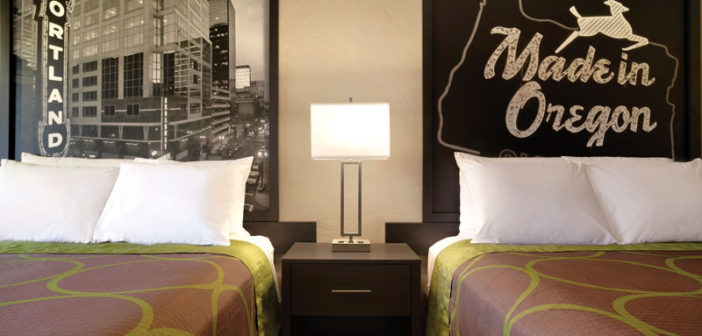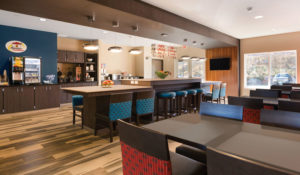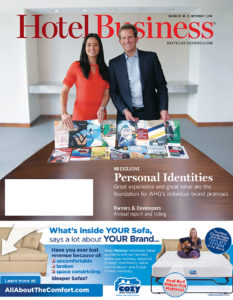Storytelling. This word has made its way into the lexicon of the hospitality industry. It’s often used when outlining the experience a hotel offers or in describing the design direction of a property. But for Parsippany, NJ-based Wyndham Hotel Group (WHG), it has become a mission. By bringing a “story,” to each of its 16 hotel brands, a definition is born, a direction decided, and a guest identified. These 16 individually crafted stories tell much about each of the brands, which, in turn, creates for the guest a place to call home away from home, and for the owner/franchisee, a marketable distinction in the economy and midscale space.
The “what” is easy: Baymont Inn & Suites; Days Inn; Hawthorn Suites by Wyndham; Howard Johnson; Knights Inn; Microtel Inn & Suites by Wyndham; Ramada Worldwide (including Ramada Encore); Super 8; Travelodge; Tryp by Wyndham; Wingate by Wyndham; Wyndham; Wyndham Garden; Wyndham Grand; and Dolce Hotels and Resorts, which was acquired last year. And the “why” is now defined (see sidebar, page 37), but it’s the “how” that WHG wanted to share with our publication.
So, when the invitation to sit down with Geoff Ballotti, CEO of WHG, was presented, Hotel Business jumped on it. What better way to understand the new branding than to chat with the hotel giant’s top executive—as well as Lisa Checchio, VP, brand marketing and insights—and take a show-and-tell journey with them through the research that has not only informed the strategies and the processes that detailed them, but reveals the inspiration behind the ideation?
With our country so focused on the political scene right now, it was refreshing to get a different take on the idea of democracy—this time, as it applies to the hotel industry: great experiences for all, no matter status. Are you an adventure-seeker? WHG has a place for you. A sophisticated and savvy traveler? There’s a place for you, too. And not just because you, as a guest, want it. Or need it. But you deserve it. Noted Ballotti, “Why shouldn’t people on a budget staying at an economy hotel have the same experience that someone might have at an upscale hotel? Income shouldn’t dictate experience.” WHG’s strategic global transformation across all 16 brands is, according to the hotel company, “the democratization of hospitality” in an attempt to reposition its iconic brands for a diverse global middle class, as well as Millennials.
We started off the interview with two words: change and evolution, and it became the perfect segue to take a deeper dive into WHG’s strategy. “We stepped back and said to ourselves, ‘We are the world’s largest economy and midscale provider—and we’re committed to that space—but how do we make our brands more relevant for the future?’” said Ballotti. “The growth occurring in this industry is really in the midscale and economy space. You see all of our big competitors wanting to get into that space with new brands. Or wanting to create a new brand, and that’s great. They all have aspirations to have brand-new properties in the next few years.”
The mission of WHG, the world’s largest hotel company—based on number of hotels with a portfolio of nearly 8,000 properties worldwide—is clear: provide great value and quality experiences at every price point. And in order to accomplish this lofty but seemingly basic goal, WHG embarked on an 18-month study focused on 50 recognized hotel brands along with the primary decision drivers of thousands of business and leisure travelers around the world. The end result? A repositioning and revitalization of its 16 economy, midscale and upscale brands to meet the needs—and desires—of travelers regardless of their budgets or traveling styles. From refreshed interiors and distinctive touches and revamped—and catchy—marketing campaigns to enhanced perks targeted to the kinds of travelers each brand welcomes, guests will, as they’re unveiled, see the fruits of WHG’s labor, which began this summer.
The campaign based on the simple premise of “belonging”—a “who are you? who we are” strategy—sets the tone of each of the WHG brands; the focus less on the brands, per se, and more on their associated lifestyles. The theory is that this approach enriches the guest experience because the guest will no longer have to sacrifice a great and memorable stay due to cost and will be able to identify with a WHG brand. Moreover, according to the executives at WHG, it’s not only about value for money, but perhaps more importantly, about the freedom to explore “your world the way you want.” WHG’s transformation unlocks the opportunity to serve the “everyman,” whose needs and preferences are often more nuanced than the existing economy options available—an opportunity that WHG identified as untapped in the industry.
Just some facts: Travel and tourism is one of the fastest-growing industries globally, with its contribution to the global GDP expected to rise from $7.2 to $11 trillion over the next decade as the global middle class more than doubles from two billion to 4.9 billion. “We’re transforming at a time when the global travel and tourism industry is growing faster than the global economy, fueled largely by Millennials and an increasingly travel-curious middle class,” said Ballotti. “We have 1,800 Days Inns, we have 2,600 Super 8s, and those brands have close to 100% brand awareness and are in the sweet spot of the market. And not only here in the U.S., but in India, where there is an emerging middle class, and in China, where we just opened our 1,100th hotel. It’s an emerging middle class that is looking for those Western-branded experiences.”
Ballotti continued, “This is why we believe this democratization of travel, where those middle-class travelers are looking for an experience that is unique and well-defined with great programming that features consistency, great quality and a great loyalty program behind it, is the way to go. With Wyndham Hotel Group’s unmatched scale and the breadth of our portfolio, no one is better positioned to meet this demand and champion the everyday traveler.”
To uncover what matters most to this “everyday traveler,” WHG partnered with NY-based Siegel+Gale, a brand strategy and experience firm, to understand guests’ preferences and priorities and, consequently, design brand experiences tailored to elevate midscale and economy hotel stays by delivering both the “wonders of travel” and great value. The research revealed key insights into traveler expectations and concluded that one size does not fit all when it comes to economy hospitality. And, moreover, that a great experience trumps status. The resulting insights created the foundation for new brand identities for owners and guests built on differentiated values and guiding principles to drive more memorable experiences for travelers. Or, in other words, said Ballotti, “We’re unlocking the potential of our iconic brands with a unique new positioning. And it’s not only an evolution, it’s been a revolution. A revelation. It’s been eye-opening for all of our teams, and we’ve had a lot of fun with it.”
He continued, “This is something that has not been done tremendously well in the economy and midscale space, and I sincerely have never been more excited than I am about what we’re doing here. Clearly and uniquely defining each brand’s positioning and then bringing that positioning to life through programming has been done so well in the luxury and upper-upscale space. And we’re ready to do it in the economy and midscale segments.”
WHG has clearly defined each brand to stand for something that matters to the kinds of guests it targets, creating meaningful identities to meet the needs of every kind of traveler, bringing to life a brand personality as unique as that of its guests. “We put personas of our guests at the center of everything we’re doing so that the future of our hotels will be what guests need it to be, what our owners need it to be, not necessarily what we want it to be,” explained Checchio.
From re-energizing American classics such as Super 8, to enriching guest expectations at Travelodge, to enhancing the experiences at Microtel Inn & Suites by Wyndham and Wingate by Wyndham—which, respectively, were named best economy/budget hotel for 14 of the last 15 years and best midscale for the second consecutive year by J.D. Power and Associates the day of our meeting—guests can anticipate changes that will capture these brand experiences and speak to what WHG calls the new brand promises. And the emphasis is on the word promise: A big difference between a message and a promise is the message says what you’re going to do. A promise is really meaning what you say. And WHG certainly means it. After all, if not all hotels are alike, neither are all travelers. To that end, each brand is differentiated from the other—and the respective comp sets—from personality-based, rather than purely transactional websites, to the guestrooms.
And while the design of the interiors is certainly crucial to the overall revitalization endeavor, the approach to design is less about the actual look—though that is significant to the upgrades—and more about creating spaces that will produce lasting memories. Economy has been totally redefined and design has helped that transformation. Every option at every price point is becoming more design-driven.
“Design is so important in value and economy products,” said Checchio. “When you think about economy hotels or midscale renovations, you might think, ‘OK, they’re nice rooms.’ But it is hard to find something that sticks, something that remains with guests when they leave.”
In this industry, we keep hearing the words local, authentic, personal. Well, WHG not only hears them but is capitalizing on what they mean to the guest experience by putting a great deal of effort into creating a connection to these values and adding elements that speak to the location and to the experience, such as featuring high-impact headboards that are consistent throughout the brand—in this case, Super 8—but individual to the property. “It lets owners personalize their hotels and, at the same time, lets guests embrace the personality so that they remember their stay,” said Checchio. “Super 8 has become their friend on the journey. We’ve provided one of those Instagrammable moments.”
WHG has noticed that just the simple act of including local artwork and scenes of America in the design has an added benefit when in comes to engagement. “A guest can now go to the front desk, reference the artwork and ask, ‘How do I get there?’ so they can go out and experience it. We’re finding that more and more,” noted Checchio. “But,” she emphasized, “We really want to be aware of the fact that we’re not just introducing something because it’s really cool to do but because it’s going to have impact, going to drive guests, drive RevPAR. It’s thoughtful design.”
Ballotti shared a real-life example of this: “We have an owner, Jay Patel, in Boston who converted a hotel that was built in 1935 to a Super 8. He has been the owner of this hotel for the past 30 years and has never been more excited. He went out and got a professional photographer who took photos of nearby historic Sturbridge Village to put in his hotel. He now has something in his market that is at a price point and at a value that no other competitor has. He’s shot to number one on TripAdvisor, and he is one engaged owner. We have hundreds of Jay Patels right now who have followed our roadmap on the ideation. We get them to buy in before we launch anything.”
WHG starts and ends every discussion with its franchise advisory council, according to Ballotti. “We’re well into the renovation and re-imagination of the Super 8 guestroom. This is one of the most engaged ownership groups we have and they love the brand, love the positioning—which focuses on the spirit and adventure of the open road—love the new artwork and love the new guestrooms.”
And it’s the same when it comes to midscale offerings, added the CEO, who noted, “The first type of prototype we launched, we went out and said, ‘We’ve got this great midscale product called Wyndham Garden. How do we take that up to its next level?’” So WHG hired NY-based design firm Krause + Sawyer. “I first met them years ago when they were doing Raffles, Peninsula and Ritz,” said Ballotti. “Well, what if we were to bring in that high-end firm to design for the midscale market? How crazy would that be to have the same quality of design but at a different price point for a developer, with a great name and a great distribution behind it? And that’s the positioning on Wyndham Garden,” said Ballotti.
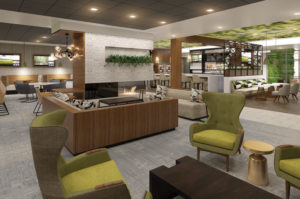
Renderings of the Wyndham Garden prototype. Whether the business lounge, guestroom or vestibule (above), the calming influence of the interiors reminds guests they can “Travel at Ease” when on the road.
He added, “When you look at our pipeline and what is selling and what franchisees are buying, and when we sit down with a developer who is looking at taking a risk of building essentially a new brand with essentially no footprint and no brand awareness or no brand equity in the market, we can say, ‘Do business with us; we have a product that we think is better than anything in the midscale space.’”
Said Checchio, “What’s most exciting about this prototype is that it’s right in line with Wyndham Garden’s new brand promise ‘Travel at Ease.’ A great space and the feeling of sunlight twinkling through a tree canopy—all of that feeling is embodied in the new branding. What’s important is that these promises are just a further definition of work that’s already been well underway. It’s just clearly articulating what the brands stand for. It’s a feeling of inspiration, a feeling of ‘We’ve walked into something special here.’”
“More than 40% of these [Wyndham Garden] properties are outside of airport or urban locations,” she continued. “You think about that hustle and bustle of travel, crowded airplanes, getting through security and getting a taxi. We want that feeling, that sense of arrival when you walk into the hotel, to feel like you’re taking a breath of fresh air. And you walk into this amazing, new, world-class-designed prototype and you are greeted with some anticipatory service and a staff who is waiting to welcome you, and it just brings the whole story to life. The message, the promise, if you will, is in all of the touchpoints. So we’re extremely excited about this prototype.”
“Our pipeline has never been stronger, we have never had more rooms in our pipeline that are new-construction—70% of our pipeline is new-construction and it’s largely because of all of this work we’re doing and the new prototypes and the ease of our franchise sales team to make a very compelling pitch to a developer,” said Ballotti. “We, organically, opened 65,000 rooms last year—that is more than anyone in the industry. That’s the equivalent of opening two hotels every day, including Saturday and Sunday. Some days we open four, some days we open one. The bulk of what’s opening is actually new prototypes that are getting built, which are designed by great design firms like a Krause + Sawyer—and we will have new prototypes for all of these brands. We already have seven new prototypes that we’ve rolled out. And that’s really important in the economy and midscale space.”
The brand promises are clearly defined in collateral. Visually enticing brochures with pithy taglines or slogans, clear descriptions and snapshots of details reinforce the messaging. “The marketing materials are well-executed and progressive, speaking to the guests’ lifestyles. It lets them identify with a particular brand saying, ‘Hey, that’s me. I want to stay there,’” said Ballotti. And more than that, it maps out a dialogue for potential and existing owners to really feel good and stand behind a product they’re building, reflagging or own as it gives them a clear understanding of “what and who we are” moving forward. It gives them a real, viable identity to be able to communicate the vision.
“It’s a little bit of swagger,” said Checchio. “These are some of the best brands in the hotel business. Days Inn, Super 8—they are some of the largest economy brands. The logos are just so iconic. Howard Johnson is celebrating 90 years. Who doesn’t have an amazing Howard Johnson story? You think about Howard Johnson and you smile. This is a part of Americana.”
She continued, “Then you look at Microtel and Wingate. I mean these are powerhouse brands. These brands deserve to be able to stand up and show who they are as brands, what their value propositions are and the value they bring to our guests.”
“The one we’re having a lot of fun with right now is what’s going on with Travelodge, which is a brand that we—through all the research and everything that came back through a positioning standpoint—realized that 50% of our Travelodge properties are within 25 miles of our national parks,” noted Ballotti. “Moreover, the National Park Service is celebrating its centennial this year, so we’ve partnered with them and we’re promoting all of its artwork in our lobbies.” The positioning that WHG landed on for this one specific brand is “Your Basecamp for Adventure,” and staying close to adventure is how the hotel company is going to bring it to life with programming. “We believe the travelers are staying close to a national park for a reason: They want to get out and go the park and don’t want to spend a lot of time to wait for a breakfast,” said Ballotti. “So, we developed this very unique and very exciting grab-and-go breakfast, which our franchisees have embraced. It’s bringing our message to every aspect of the hotel experience.” Added Checchio, “It could be music, textiles, refreshments, art—the messaging can manifest itself in so many ways in all of these different brands.”

Ideation sessions produced an innovative approach to marketing WHG’s brands. Based on the persona of guests, 16 brand personalities emerged.
According to the CEO, the owners of all of the Travelodge hotels receiving the corresponding collateral are not only excited, but satisfied and happy. “They are loving the artwork, loving the healthy option grab-and-go. The whole rollout has given a feeling of excitement to the teams and the owners we haven’t seen in a while,” noted Ballotti. “And the owners are excited this is only for Travelodge,” added Checchio. “Owners are taking pride in this positioning and this partnership with the National Park Conservation Association, which can only be offered by Travelodge. You start to put a little guardrail between the brands so that their collective strength is what the strength of the portfolio is, but when we get into the individual brands, there’s a sense of pride now and excitement that ‘This is only for us. This is not a cookie-cutter approach.’”
In talking about the design prototypes and the go-forward strategy, the topic of the sharing economy came up. Hotel Business asked if the residential feeling of the interiors, the price point, the locally inspired atmosphere, will enable WHG to compete with, or disrupt, the disrupters, i.e., Airbnb. Ballotti responded: “Guests are certainly looking for a new experience and they’re going to see, feel and hear in our advertising and marketing that there’s something new going on. I think, at the same time, they are looking for amenities that are not necessarily available in the sharing economy or someone else’s home. I think what we’re doing in terms of something that’s never been tried to the extent we’re trying it in the economy and midscale space, will certainly better position these hotels.”
He continued, “What’s most important for owners aside from contribution is market-share growth. Is their RevPAR index growing against their competitive set? Are they gaining share? And if they’re gaining share, we’re beginning to see that month-in, month-out these economy brands gain share against their set. And that’s the ultimate test for any owner from a disruption standpoint. If you have a brand that is defined as these brands are becoming, I do think you’re right, I think we could be disruptive from a market-share standpoint.”
But it’s not just about messaging and design, it’s about the big picture. About trying to reach the next-generation of travelers and gaining their loyalty, about “quality control” within the entire portfolio and about streamlining operations, among other tactics.
While there is a cross-generational approach to the identity strategy, there certainly is an element of appeal that will resonate with a more youthful generation.” I think what we’re all about and what we’re doing is what the next generation is looking for,” said Ballotti. “It’s a very bright generation looking for great design, great value at a great price. Obviously, we all want clean and well-maintained rooms, but we’re giving them the icing on the cake with this type of feel, this type of vibe, this type of atmosphere and ambiance they’re not going to find at that price point in any economy or midscale hotel across the byways and highways of America. I think we can own that space.”
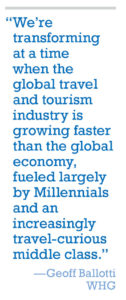 The CEO noted that Millennials are incredibly brand loyal, sharing a personal anecdote: “We’ll drive out of our way to find a Starbucks and Chick-fil-A for my Millennial children. But they don’t want to be told, ‘This is for you because you’re a Millennial.’ They like to think they discovered it.”
The CEO noted that Millennials are incredibly brand loyal, sharing a personal anecdote: “We’ll drive out of our way to find a Starbucks and Chick-fil-A for my Millennial children. But they don’t want to be told, ‘This is for you because you’re a Millennial.’ They like to think they discovered it.”
Added Checchio, “I think Millennials want choice and they want to feel like they’re in control, so by having the breadth of our portfolio, we are where they want to be. This is why we’re not targeting one brand, like many others are. We can still give them the freedom of choice to choose the way they want to travel at any price point and to have the freedom of adventure, but backed up by a well-established brand.”
Ballotti said he is often asked which of the 16 brands is WHG’s “Millennial brand.” And his answer? “Well, all of them appeal to Millennials. And what ties them all together more than anything for Millennials—because we do believe they are brand loyal—is Wyndham Rewards.”
Wyndham Rewards, WHG’s loyalty program, has seen a significant increase in new members since the rollout of its single-tier redemption approach, and recently added an “elite” program for all, which offers discounts on local experiences for no additional points at its top destinations around the world. (See accompanying sidebar.) “What we did with our loyalty program—and we got each and every one of the owners to feel comfortable with this to the point that they support this program more than anything else I’ve ever see an ownership group support—was to make it less complex and more valuable because of our size and our scale,” said Ballotti. “In essence, we’ve taken the industry back to when loyalty programs began, when it was clear to everybody what it took to get a free flight or a free night. No black-out dates but, more importantly, no redemption levels. Instant gratification. It’s so transformational.”
Not to mention the Wyndham Rewards Wyzard [Kristofer Hivju who plays Tormund Giantsbane on the super-popular Game of Thrones.] Ballotti said with a smile, “I can’t tell you how many Millennials, when you say you work for Wyndham, are like, ‘Wait, you work for the company with the wizard?’ It has totally brought brand awareness to a different generation.”
On another front, WHG upgraded its back-end technology and is the first hotel company of its scale to roll out a secure, cloud-based property management system (PMS) with automated revenue management capabilities to the majority of is portfolio. More than 300 hotels are converting to this system each month and, according to WHG, hotels that have adopted it have seen an increase in RevPAR.
“We made a transformational pivot two years ago when we said we would much rather invest our resources, time, effort, money and energy in great branding and great brand positioning than we would in developing central system technology solutions,” noted Ballotti. “And so we made a decision to get out of building our own central reservation and property reservation systems, which we had been doing for decades—and which big brands are still doing today—and decided to partner with world-class providers who are in the business of doing just that.” WHG selected three of the industry’s most-proven technology providers: From a central system standpoint, the hotel company selected Sabre; from a property management and reservations system standpoint, it combined Sabre’s PMS with Infor’s automated revenue management system; and WHG moved all of its data outside of its servers to the Amazon cloud. “We believe this will be a strategic advantage for us going forward that will bolster market share and RevPAR index,” said Ballotti.
Furthermore, WHG has been saying goodbye to subpar properties and is improving the quality of its portfolio, having increased the number of substandard properties removed by three times over the past two years while adding more than 650 new-build hotels to its pipeline, including hotels under its LEED-certifiable Days Inn and Super 8 prototypes, along with Microtel Inn & Suites by Wyndham and Wingate by Wyndham brands. “Consistently growing the product with quality is what matters most to our franchisees,” said Ballotti. “And so, not only did we open more rooms last year, we took out more rooms than we’ve ever taken out. So last year, of the 48,000 rooms that left the system, 44,000 rooms did not meet our quality standards. That work is ongoing. But each year, you’re saying goodbye to fewer rooms because they’re meeting the level of quality.”
And the enhancements don’t stop there. Take, for example the recently introduced new functionality for the Wyndham Rewards app. With one click, Wyndham’s agents will call users at their desired time and locate a hotel based on current GPS coordinates. This refocus of customer-service efforts to adjust to consumers’ demands to fit their schedules is a first-of-a-kind feature for any hotel app, according to WHG. “This app was the biggest mover in the app world last year, making it simpler and easier to book,” said Ballotti. “The owners are embracing it because it’s helping the owners fill. And that’s what it’s about.”
“This entire transformation is just the beginning of our journey to not only solidify our position as one of the most formidable players in hospitality, but to champion the everyday traveler and the experiences they deserve,” Ballotti concluded. HB
On Point: Defining the Brands
What’s in a name? For WHG, great experience and great value. Thanks to short phrases that resonate with owners and guests alike, each of WHG’s brands offer identities that target the type of traveler historically associated with the brand, and offer, in a few words, a snapshot of why guests might choose to stay there. Following are the brands and their new identifiers:
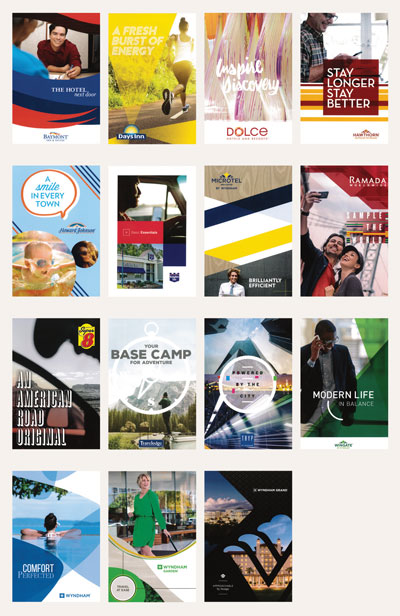 Baymont Inn & Suites—The Hotel Next Door
Baymont Inn & Suites—The Hotel Next Door
Days Inn—A Fresh Burst of Energy
Dolce Hotels and Resorts—Inspire Discovery
Hawthorn Suites by Wyndham—Stay Longer, Stay Better
Howard Johnson—A Smile in Every Town
Knights Inn—Basic Essentials
Microtel Inn & Suites by Wyndham—Brilliantly Efficient
Ramada Worldwide—Sample the World
Super 8—An American Road Original
Travelodge—Your Basecamp for Adventure
Tryp by Wyndham—Powered by the City
Wingate by Wyndham—Modern Life in Balance
Wyndham—Comfort Perfected
Wyndham Grand—Approachable by Design
Wyndham Garden—Travel at Ease
We’re number one
Just a few weeks ago, U.S. News & World Report announced that Wyndham Rewards unseated Marriott to top the list of Best Hotel Rewards Programs for 2016-17. This is a first for Wyndham Hotel Group. The annual ranking identifies 28 hotel (and airline) loyalty programs with the most-rewarding perks. Prior to this, Marriott has held the coveted spot since the media outlet began ranking hotel rewards programs. This number-one spot is a huge milestone for Wyndham Hotel Group as it confirms, for the hotel company, its strategic course of action was the right one.
It was less than a year-and-a-half ago that the company re-imagined Wyndham Rewards, overhauling the entire program to center around simplicity and generosity. Following the unveiling of the new program, the company jumped from seventh to second place in last year’s ranking. And, now, with the move to number one, it signals an unprecedented jump in a short amount of time.
The ranking comes on the heels of the company’s launch in May of Member Levels—the newest enhancement to the program—which is Wyndham’s version of an elite program for the masses. In short, through four levels—Blue, Gold, Platinum and Diamond—Wyndham Rewards members can take advantage of new benefits that increase by level, from free WiFi and rollover nights to annual point bonuses.
Moreover, when members redeem their points for a stay at one of the program’s top 25 destinations, they now automatically receive an additional enhancement to their award night for no additional points, broadening their ability to capitalize on experiences local to the destination.
Since relaunching the program last year, Wyndham Rewards has added nearly seven million new members, increased its awareness by 30%, and redeemed more than one million reward nights, according to the hotel company. Furthermore, the program has been upgraded to offer additional benefits such as early check-in, late checkout, free amenities and suite upgrades.
“We believe a great loyalty program should be simple and generous, offering perks and rewards that benefit all,” said Noah Brodsky, SVP of Worldwide Loyalty and Engagement at Wyndham Hotel Group. “We’re leveling the playing field. Whether you spend two nights a year in a hotel or 200, Wyndham Rewards is built for the everyday traveler. No other program lets you earn more or redeem faster.”
Choice Privileges and Marriott Rewards tie at number two.

